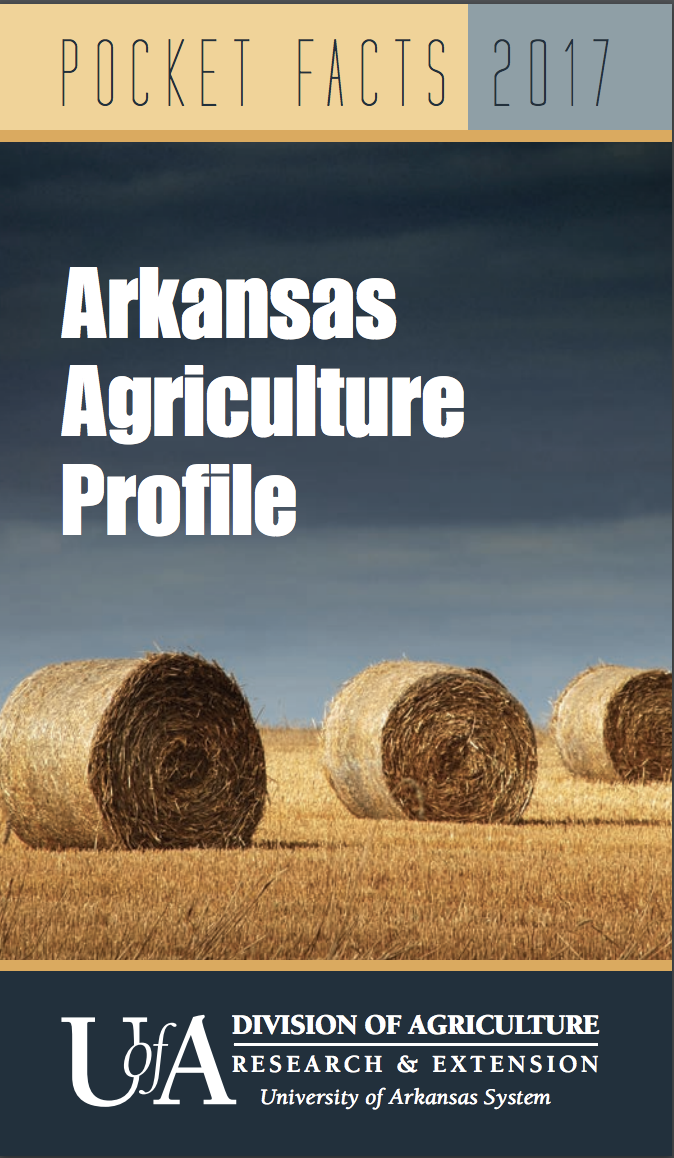Pocket-sized ‘Profile’ gives big picture of Arkansas agriculture
March 20, 2018
By Mary Hightower
U of A System Division of Agriculture
Fast Facts
- Arkansas Agriculture Profile available in print, online
- Pocket guide updated to include 2017 stats
- Find publication online at http://bit.ly/ArkAgProfile2018
(507 words)
Download Word version
FAYETTEVILLE, Ark. – A pocket-sized guide that provides the big picture of Arkansas’ largest industry is now available online.
Formerly known as “Economic Contributions of Arkansas Agriculture,” the “Arkansas Agriculture Profile” has changed since its last edition in 2014, including more infographics, expanding the section on the state’s forestry industry and condensing the list of sources onto one page. (Find a PDF at http://bit.ly/ArkAgProfile2018)

“This booklet presents a concise look at Arkansas’ multi-faceted agricultural industry,” said Mark Cochran, vice president-agriculture for the University of Arkansas System and head of its Division of Agriculture. “Many people don’t realize the impact Arkansas agriculture has, contributing 17.1 percent of the state’s value added, or $21.4 billion, and this does not include the retail food sector; for example, grocery stores, restaurants and food service establishments.
“That means a lot of dollars flowing through our communities, both rural and urban,” he said. “This publication has been useful to policy makers, analysts and others, and is part of our mission in helping agriculture remain a well-tuned economic engine for Arkansas.”
That 17.1 percent figure includes the total value generated by agriculture, including purchases of goods and services such as fuel, electricity, financial services and more by the agricultural industry, said Wayne Miller, extension economist for the Division of Agriculture. The figure also includes spending by agriculture industry owners and employees on consumer goods and services such as groceries, clothing, automobiles and other things that expand Arkansas’ retail and service sectors.
The booklet has been one of the most requested publications from the University of Arkansas System Division of Agriculture since it was first published in 2007, back when it was called “Economic Impact of Arkansas Agriculture.”
The publication was based on the 2006 research publication “Impact of the Agricultural Sector on the Arkansas Economy in 2003,” a study by Jennie Popp, Nathan Kemper and Miller. Popp, associate dean of the Honors College at the University of Arkansas, was an agricultural economist with the UA System’s Division of Agriculture at the time. Kemper, a program associate with Popp at the time, is an assistant professor of agricultural economics and agricultural business within the division and the Bumpers College of Agricultural, Food and Life Science.
Popp authored the current edition along with Leah English, a technical assistant in the Division of Agriculture.
Over the years, “there were some changes in the development of the data we purchase and use to calculate the values in this book, and because it’s such a well-used reference for the industry, we wanted to be sure that the integrity of the data was maintained,” Popp said of the gap between the 2014 and 2018 editions.
In 2016, Arkansas’ top commodities in terms of cash receipts included more than $3.1 billion in broilers, $1.4 billion in soybeans and $1 billion in rice, according to the profile publication. However, Miller said the publication also helps illustrate the diversity of agriculture within the state.
“It’s not just the Delta row crops, or the livestock and poultry production,” Miller said. “It’s also forestry, specialty crops and sod production. Those activities are also important components of agriculture in Arkansas.”
The guide is available in limited quantities as a hard copy. E-mail mhightower@uada.edu for more information.
About the Division of Agriculture
The University of Arkansas System Division of Agriculture’s mission is to strengthen agriculture, communities, and families by connecting trusted research to the adoption of best practices. Through the Agricultural Experiment Station and the Cooperative Extension Service, the Division of Agriculture conducts research and extension work within the nation’s historic land grant education system.
The Division of Agriculture is one of 20 entities within the University of Arkansas System. It has offices in all 75 counties in Arkansas and faculty on five system campuses.
Pursuant to 7 CFR § 15.3, the University of Arkansas System Division of Agriculture offers all its Extension and Research programs and services (including employment) without regard to race, color, sex, national origin, religion, age, disability, marital or veteran status, genetic information, sexual preference, pregnancy or any other legally protected status, and is an equal opportunity institution.
# # #
Media Contact: Mary Hightower
Dir. of Communication Services
U of A System Division of Agriculture
Cooperative Extension Service
(501) 671-2126
mhightower@uada.edu